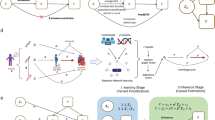Abstract
The ability to detect recent natural selection in the human population would have profound implications for the study of human history and for medicine. Here, we introduce a framework for detecting the genetic imprint of recent positive selection by analysing long-range haplotypes in human populations. We first identify haplotypes at a locus of interest (core haplotypes). We then assess the age of each core haplotype by the decay of its association to alleles at various distances from the locus, as measured by extended haplotype homozygosity (EHH). Core haplotypes that have unusually high EHH and a high population frequency indicate the presence of a mutation that rose to prominence in the human gene pool faster than expected under neutral evolution. We applied this approach to investigate selection at two genes carrying common variants implicated in resistance to malaria: G6PD1 and CD40 ligand2. At both loci, the core haplotypes carrying the proposed protective mutation stand out and show significant evidence of selection. More generally, the method could be used to scan the entire genome for evidence of recent positive selection.



Similar content being viewed by others
References
Ruwende, C. & Hill, A. Glucose-6-phosphate dehydrogenase deficiency and malaria. J. Mol. Med. 76, 581–588 (1998)
Sabeti, P. et al. CD40L association with protection from severe malaria. Genes Immun. 3, 286–291 (2002)
Cavalli-Sforza, L. L., Menozzi, P. & Piazza, A. The History and Geography of Human Genes (Princeton Univ. Press, Princeton, 1994)
Kimura, M. The Neutral Theory of Molecular Evolution (Cambridge Univ. Press, Cambridge/New York, 1983)
Stephens, J. C. et al. Dating the origin of the CCR5-Delta32 AIDS-resistance allele by the coalescence of haplotypes. Am. J. Hum. Genet. 62, 1507–1515 (1998)
Hudson, R. R. & Kaplan, N. L. Statistical properties of the number of recombination events in the history of a sample of DNA sequences. Genetics 111, 147–164 (1985)
Lewontin, R. The interaction of selection and linkage. I. General considerations; heterotic models. Genetics 49, 49–67 (1964)
Nei, M. Molecular Evolutionary Genetics Eqn. 8.4 (Columbia Univ. Press, New York, 1987)
Luzatto, L., Mehta, A. & Vulliamy, T. The Metabolic & Molecular Bases of Inherited Disease 4517–4553 (McGraw-Hill, New York, 2001)
Raymond, M. & Rousset, F. An exact test for population differentiation. Evolution 49, 1280–1283 (1995)
Hudson, R. R. Properties of a neutral allele model with intragenic recombination. Theor. Popul. Biol. 23, 183–201 (1983)
Reich, D. E. & Goldstein, D. B. Microsatellites: Evolution and Applications 128–138 (Oxford Univ. Press, Oxford/New York, 1999)
Tishkoff, S. A. et al. Haplotype diversity and linkage disequilibrium at human G6PD: recent origin of alleles that confer malarial resistance. Science 293, 455–462 (2001)
Rozas, J. & Rozas, R. DnaSP version 3: an integrated program for molecular population genetics and molecular evolution analysis. Bioinformatics 15, 174–175 (1999)
Tajima, F. Statistical method for testing the neutral mutation hypothesis by DNA polymorphism. Genetics 123, 585–595 (1989)
Fu, Y. X. & Li, W. H. Statistical tests of neutrality of mutations. Genetics 133, 693–709 (1993)
Fay, J. C. & Wu, C. I. Hitchhiking under positive Darwinian selection. Genetics 155, 1405–1413 (2000)
Hughes, A. L. & Nei, M. Pattern of nucleotide substitution at major histocompatibility complex class I loci reveals overdominant selection. Nature 335, 167–170 (1988)
McDonald, J. H. & Kreitman, M. Adaptive protein evolution at the Adh locus in Drosophila. Nature 351, 652–654 (1991)
Hudson, R. R., Kreitman, M. & Aguade, M. A test of neutral molecular evolution based on nucleotide data. Genetics 116, 153–159 (1987)
Gabriel, S. B. et al. The structure of haplotype blocks in the human genome. Science 23, 2225–2229 (2002)
Wootton, J. C. et al. Genetic diversity and chloroquine selective sweeps in Plasmodium falciparum. Nature 418, 320–323 (2002)
Tang, K. et al. Chip-based genotyping by mass spectrometry. Proc. Natl Acad. Sci. USA 96, 10016–10020 (1999)
Vulliamy, T. J. et al. Linkage disequilibrium of polymorphic sites in the G6PD gene in African populations and the origin of G6PD A. Gene Geogr. 5, 13–21 (1991)
Sachidanandam, R. et al. A map of human genome sequence variation containing 1.42 million single nucleotide polymorphisms. Nature 409, 928–933 (2001)
Reich, D. E. et al. Linkage disequilibrium in the human genome. Nature 411, 199–204 (2001)
Acknowledgements
We thank B. Blumenstiel, M. DeFelice, A. Lochner, J. Moore, H. Nguyen and J. Roy for assistance in genotyping the 17 control regions. We also thank L. Gaffney, S. Radhakrishna, T. DiCesare and T. Lavery for graphics and technical support, B. Ferrell for the Beni samples, and A. Adeyemo and C. Rotimi for helping to collect the Yoruba and Shona samples. Finally, we thank M. Daly, E. Cosman, B. Gray, V. Koduri, T. Herrington and L. Peterson for comments on the manuscript. P.C.S. was supported by grants from the Rhodes Trust, the Harvard Office of Enrichment, and by a Soros Fellowship. This work was supported by grants from the National Institute of Health.
Author information
Authors and Affiliations
Corresponding author
Ethics declarations
Competing interests
The authors declare that they have no competing financial interests.
Supplementary information
Rights and permissions
About this article
Cite this article
Sabeti, P., Reich, D., Higgins, J. et al. Detecting recent positive selection in the human genome from haplotype structure. Nature 419, 832–837 (2002). https://doi.org/10.1038/nature01140
Received:
Accepted:
Published:
Issue Date:
DOI: https://doi.org/10.1038/nature01140
- Springer Nature Limited
This article is cited by
-
Comparative genomic analyses provide new insights into evolutionary history and conservation genomics of gorillas
BMC Ecology and Evolution (2024)
-
Genome-wide detection of positive and balancing signatures of selection shared by four domesticated rainbow trout populations (Oncorhynchus mykiss)
Genetics Selection Evolution (2024)
-
Reconstructing the ancestral gene pool to uncover the origins and genetic links of Hmong–Mien speakers
BMC Biology (2024)
-
IBD sharing patterns as intra-breed admixture indicators in small ruminants
Heredity (2024)
-
Genomics reveals heterogeneous Plasmodium falciparum transmission and selection signals in Zambia
Communications Medicine (2024)





